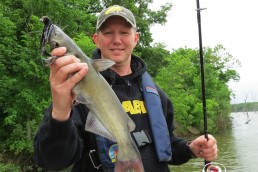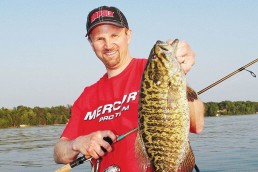May Channels Provide Great Early-season Action
SHARE THIS POST
From late spring to summer, channel catfish make for great action on Kentucky and Barkley lakes.
Prowl the shoreline. And whether you’re in a boat or onshore, seek the eating-sized catfish known as “fiddlers.” Fiddlers are those 2-to 4-pound cats believed by many to be the best-tasting fish.
Channels often prefer a nightcrawler presentation closer to the bottom, but they will take something from anglers fishing for redear sunfish.
Anglers fish for these catfish with a variety of techniques. Moving slow along the shoreline and cast to locations that have produced consistently. On Kentucky and Barkley lakes, anglers find channels in the shallow bays and other areas with riprap, and check areas with larger chunks of rock.
As fish move toward the shore to spawn, they are vulnerable. Sometimes all you need is a good sharp hook, a cork, a small piece of lead or a can of old earthworms.
Another popular rig for channels is a nightcrawler on a slip-sinker rig. To make the rig, tie a 4/0 circle hook on an 18-inch fluorocarbon or monofilament leader. Tie a barrel swivel on the other end of the leader, and then take the main line and thread it through a 1/2- to 1/4-ounce egg sinker and plastic bead before tying the line to the other eyelet of the barrel swivel. Fish will be on the rocks here for a month or more, allowing time for anglers to get in on the action. This begins when the water temperatures reach the mid- to upper 60s.
Are you enjoying this post?
You can be among the first to get the latest info on where to go, what to use and how to use it!
A big mistake is made when using too large of a hook. Circle hooks work well as a fish hooks itself when pulling the line. A number 4 size hook that is very stout and sharp is just the ticket. Just skewer a nightcrawler and you will be in the action.
Catfish twist and roll once they know they’re hooked. This can twist and fray the line, and in many cases, break it off. By placing the swivel about 12 to 18 inches above the hook, the lower portion of the line can twist with the fish without affecting your main line.
Catfish feed by smell, and all one needs is a small piece of worm to catch a big fish. Many anglers use 12-pound-test line that matches the water’s color. They place a cork 2 1/2 to 3 feet above the bait. A small lead sinker about 6 inches above the bait will keep the cork upright and the bait just above the rocks.
During May and early June, catfish will be about 3 to 4 feet from the bank over the rocks. These months are prime time to fish due to the milder temperatures and lack of crowding. The main summer influx of campers and family vacationers has not begun.
Knowing which cats you’re after or have hooked and the best conditions for these is important. You can distinguish channel cats from the flatheads and blue catfish by a rounded anal fin and small black spots on the sides of their bodies. And as water temperatures rise into the 70s, all catfish will begin to feed aggressively prior to beginning their spawning activities.
MWO
SHARE THIS POST
You may also like...
0 CommentsGreat Shallow-water Bass Action Right Now
Did you enjoy this post?
You can be among the first to get the latest info on where to go, what to use and how to use it!
Don Gasaway
Don Gasaway is a veteran freelance outdoor writer from Marion, Ill. He may also be found at: https://www.facebook.com/DonGasawayWriter and facebook.com/Wandering Angler. Comments are welcome


